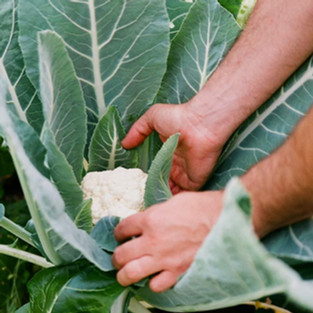Let's Store Veggies and Fruits... the Right Way!
- Twinstone Ranch
- Aug 7, 2021
- 4 min read
It happens to all of us – you buy fresh produce and stick it in the refrigerator only to find it a few weeks later looking shriveled and rotten.
To avoid throwing it out, it’s important to know where to store fruits and vegetables and also which foods to keep separate from each other. Some fruits give off ethylene gas, which can make other produce ripen and rot faster.
These storage tips will help keep your fruit and vegetable purchases fresher longer so you get your money’s worth and live sustainably.

General Storage Tip– Some produce can be stored in the refrigerator at 40° F or below or on the counter. Refrigerate all produce that is purchased pre-cut or peeled.
Fruits
Apples - Apples are ethylene gas producers so store away from other produce. They can be stored on the counter for up to a week or in the fridge for more than a week.
Avocados – Ripen on the counter then store in the refrigerator.
Bananas – Keep green bananas out of the refrigerator and let them ripen on the counter or a banana hanger.
Berries – Blueberries, blackberries, strawberries and raspberries are delicate and should not be washed until ready to eat. Keep in refrigerator in dry, covered containers.
Cherries & Grapes – Store in refrigerator, unwashed, in their packaged plastic containers or plastic bags until ready to wash and eat.
Citrus fruit – Extend the shelf life of clementines, grapefruit, lemons, limes and oranges by storing them in the crisper drawer or in a mesh bag in the refrigerator.
Melons - Store cantaloupe and honeydew loose in the refrigerator, even before they’re cut. Watermelon can be kept in a dark, dry place away from other produce. Keep cut melon in the fridge.
Stone fruit – Keep nectarines, peaches and plums in a paper bag on the counter until they are ripe then move to the refrigerator where they’ll last a few more days.
Tomatoes – Always store at room temperature as the refrigerator will make them rot quickly. Keep loose in a bowl away from sun or heat (like the stove.)
Vegetables
Broccoli & Cauliflower – Broccoli and cauliflower are best kept in separate refrigerator drawers away from other produce.
Celery – Store in the refrigerator.
Corn – Store in the refrigerator inside their husks.
Cucumbers – Store at room temperature. Can be kept in the refrigerator for 1 to 3 days if they are used soon after removal from the refrigerator.
Eggplant – Store at room temperature. Can be kept in the refrigerator for 1 to 3 days if they are used soon after removal from the refrigerator.
Green beans – Store in the refrigerator.
Leafy green vegetables – Greens like lettuce, collards, chard, kale, and spinach should be stored in the refrigerator.
Onion family – Store garlic and onions in a cool, dark and dry space but separate from other foods because of their strong odors.
Mushrooms – Keep unwashed in the refrigerator. Moisture makes them slimy.
Peppers – Store at room temperature. Can be kept in the refrigerator for 1 to 3 days if they are used soon after removal from the refrigerator.
Root vegetables – Store carrots, beets, and radishes in the refrigerator. Store potatoes, sweet potatoes and winter squashes in a cool, dark and dry place like a pantry or cellar.
Storage times are different for each type of vegetable
The guidelines below are for vegetables at their best quality. They still may be safe to eat after the stated times as long as they are not mouldy or rotten.
Vegetable How Long? Notes
Cupboard/cool room temperature
Potatoes 1-2 weeks (2-3 months in a cool, dark place)
Tomatoes 1-5 days
Onions 1-2 months
In the fridge
Asparagus 3-4 days
Beans (green, wax) 3-5 days
Beets 2 weeks
Broccoli 3-5 days
Brussels sprouts 3-5 days
Cabbage 1 week
Carrots 3-4 weeks
Cauliflower 1 week
Celery 1-2 weeks
Corn 1-2 days
Cucumbers 1 week
Green onions 7-10 days
Lettuce 1 week
Mushrooms 4-7 days
Parsnips 3-4 weeks
Peas in the pod 3-5 days
Peppers (green, red) 1-2 weeks
Potatoes (new) 1 week
Rutabaga 2-3 weeks
Spinach 3-5 days
Sprouts 3-5 days
Squash (summer) 4-5 days e.g. zucchini, patty pan
Most vegetables, like carrots, potatoes, broccoli, cabbage and celery should be stored in a plastic bag or container in the crisper of your fridge. Mushrooms are best stored in a paper bag. Vegetables should be stored in a different part of the fridge than fruit. This will prevent them from ripening too fast.
Freeze your vegetables if you can’t eat them right away
Freezing vegetables at home is a fast and easy way to preserve nutrients and enjoy the taste of summer vegetables all year long.
Most vegetables need to be blanched before they are frozen. This means that you should boil the whole or cut up pieces of the vegetable for 1-2 minutes and then immediately place in ice cold water to stop the cooking process. This will keep your vegetables from getting freezer burn. Frozen vegetables will be fine for up to one year.
Freezing is not recommended for artichokes, Belgian endive, eggplant, lettuce greens, potatoes (other than mashed), radishes, sprouts and sweet potatoes.
We gathered most of this information from different websites to compile a full list with information we thought could be very useful. Please remember that this is a guide not a rule and that all produce should be checked before consumption.



















Comments